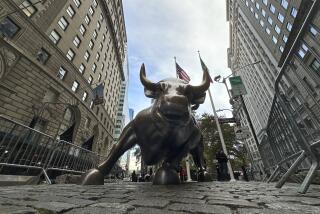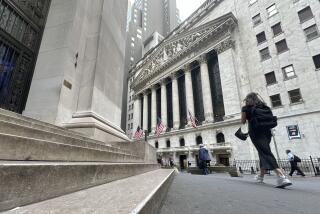Where to Hide When Bears Attack
Stock prices have been dropping since the beginning of the year, and it more and more looks like a genuine bear market of some duration. The Dow Jones industrial index went to new highs Jan. 2, but the broader Standard & Poor’s 500 index never got past its October peak and the even broader market never got close. Since then, all indexes have fallen and the S&P; 500 is down 10%. Most Wall Street wizards now tell you that the correction they didn’t foresee is about over. Beware! It sounds like the same complacency that ruled just before the 1987 crash.
Investors concentrated last year on a relatively few takeover stocks. That told me that shareholders were suspicious over the health of the basic economy that the broad market mirrors. Indeed, the leveraged buyouts were about the only source of support for stocks in 1989. It certainly wasn’t corporate earnings. Economic operating profits fell 20% during the four quarters of last year. In the final quarter alone, 53% of a widely followed list of companies reported earning below analysts’ forecasts, and those disappointments averaged a whopping 49% below Wall Street estimates.
Stock prices normally respond to earnings and, in the postwar period, have consistently dropped when bottom lines fell at the end of business expansions. But last year, the S&P; 500 rose 32% instead because of three forms of LBO support. First, takeover stocks were bought out at highly inflated prices. Second, the stock prices of rumored and hoped-for takeover candidates were bid up as well. Remember how a whole flock of airline stocks soared after the UAL buyout was announced?
Third, many companies increased their dividends enormously last year to push up their stock prices. This discouraged hostile takeovers by making it more expensive for raiders to buy those stocks. S&P; 500 dividends per share rose 136% in 1989, an extraordinary hike in the face of the steep earnings drop. In fact, the dividend payout ratio, which normally falls in the waning days of a business expansion as corporate boards get cautious, soared from 36% in the third quarter of 1988 to 56% in the fourth quarter of 1989. (That ratio measures the percentage of corporate earnings paid out in dividends.)
Sure, some stocks of big companies that were not big takeover targets did well last year as investors headed for the safe haven of food, beverage, drug, telephone company and other stocks that offer stability and predictability in a recessionary climate. But in the main, it was an LBO-dominated stock market. Smaller company stocks that were not subject to takeover activity did poorly. The Value Line composite, which gives equal weight to medium and small firms, rose only 11% in 1989. An equally weighted index of 6,000 stocks, most of them small, gained a minuscule 5%, with 45% falling in price.
With the disintegration of junk bonds in the past six months, however, the likelihood of new LBOs financed by them is remote, to put it mildly. The demise of Drexel Burnham Lambert was only the final nail in their coffin. So, no more high takeover bids for stocks, hostile or otherwise. And, without the weapon of junk bonds, the raiders are impotent.
Coupling this fact with deteriorating earnings, corporations will cut dividends, not raise them, this year. It’s easy to see a give-back of last year’s 32% increase in the S&P; 500, especially since that index contains many companies that were part of the takeover whirl. It’s also easy to envision a further big drop in stock prices as investors shift their attention to the disappointing and relentless earnings decline. A revisiting of the 1987 crash lows--about a 50% total drop in prices--is a distinct possibility, especially if I’m right that the recession will be global and deep.
How do you invest in this climate? Despite the rise in interest rates in January, high-quality interest-sensitive securities are still the best place to be, for my money. Rely on Treasury bonds, municipal obligations rated AA or better and high-quality utility stocks. These will provide great locations from which to watch the recessionary action on the investment field. The weaker the economy, the more you’ll make in these instruments.
And, the less you’ll lose by not being in cyclic stocks. Bail out of those you still own now, even at depressed prices. Dump LBOs, actual or rumored, and junk bonds (I hope you don’t own any). Sure, there’s a difference between “good junk” and “bad junk,” but until the recession really gets rolling and dries up cash flow, it’s too early to tell a sheep from a goat. Even RJR Nabisco’s junk is at risk. Besides, all junk bonds, good or bad, may be under pressure for some time. Sell commodities and other tangible assets. Avoid Japanese stocks; that market is destined for a further big fall. Get ready to buy growth stocks, but later at cheaper prices.
Above all, don’t look for the stock market slump to be another 1987 crash--a nose dive that is breathtaking, but ends quickly. Nature is seldom accommodative enough to let you fight the last war all over again. Instead, anticipate a Chinese water torture market that features relentless, frustrating, boring declines with a few temporary rallies to break the monotony. We haven’t had one since 1973, so long ago that few investors and even fewer stockbrokers know what it’s like. Brace yourself for a miserable stock market, but do so against a solid wall of high-quality bonds.
More to Read
Inside the business of entertainment
The Wide Shot brings you news, analysis and insights on everything from streaming wars to production — and what it all means for the future.
You may occasionally receive promotional content from the Los Angeles Times.










